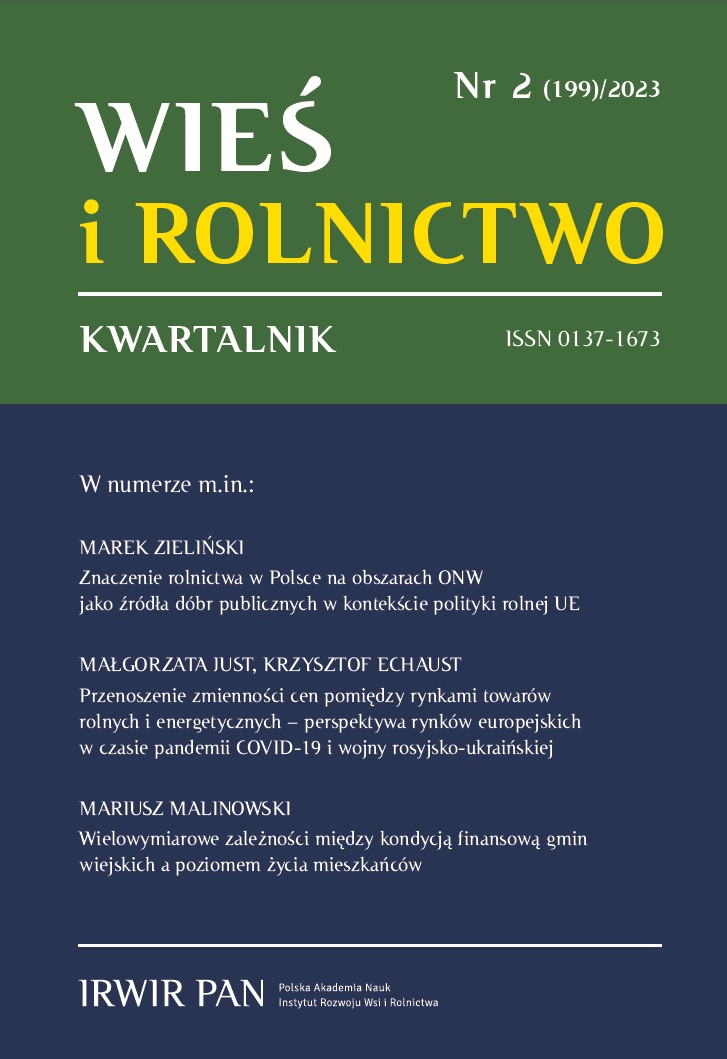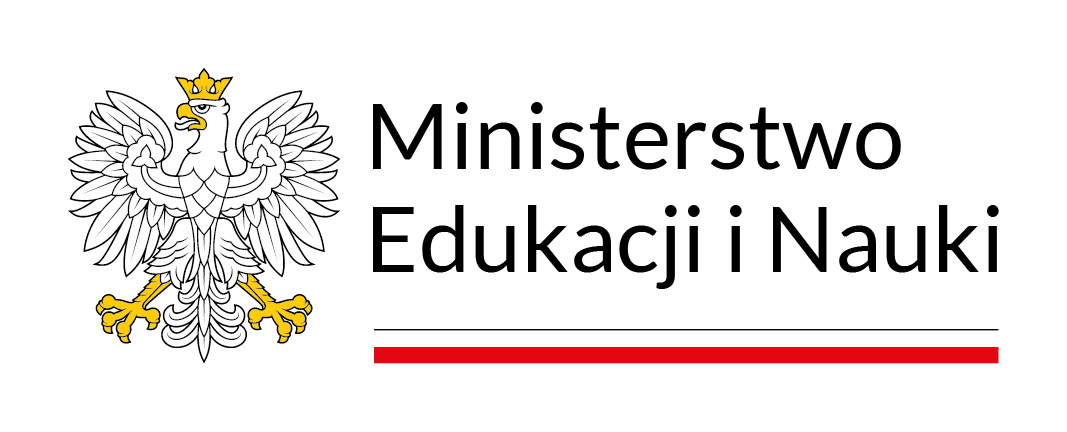Przenoszenie zmienności cen pomiędzy rynkami towarów rolnych i energetycznych – perspektywa rynków europejskich w czasie pandemii COVID-19 i wojny rosyjsko-ukraińskiej
DOI:
https://doi.org/10.53098/wir022023/02Słowa kluczowe:
zmienność cen, przenoszenie zmienności, towary rolne, towary energetyczneAbstrakt
Celem pracy była ocena powiązań w zakresie zmienności cen pomiędzy pięcioma rynkami terminowymi z giełd Euronext i ICE: pszenicy, kukurydzy, rzepaku, ropy Brent i gazu ziemnego w okresie styczeń 2017–styczeń 2023, a w szczególności wskazanie rynków będących dominującym źródłem zmienności wśród rozpatrywanych. Do przeprowadzenia tej oceny zastosowano indeks przenoszenia zmienności Diebolda-Yilmaza bazujący na uogólnionej dekompozycji wariancji błędu prognozy oraz jego rozszerzenie w dziedzinie częstotliwości Baruníka-Křehlíka. Okres od wybuchu pandemii COVID-19 do początku 2023 r. wiąże się ze wzrostem zmienności cen na rynkach żywności i energii. W czasie pandemii COVID-19 efekt przenoszenia zmienności pomiędzy rynkami był dwukrotnie silniejszy niż w latach 2017–2019, a podczas wojny rosyjsko-ukraińskiej trzykrotnie. Główne źródło szoków rynkowych w okresie rozprzestrzeniania się wirusa SARS-CoV-2 stanowił rynek rzepaku, podczas gdy w czasie działań wojennych w Ukrainie rolę tę przejął rynek pszenicy. Zmienność nie była przenoszona natychmiastowo, dając tym samym szansę na wdrożenie procedur zarządzania ryzykiem, które łagodziłyby wpływ szoków pochodzących z jednego rynku na pozostałe.
Bibliografia
Abbott P.C., Hurt C., Tyner W.E. (2009). What’s Driving Food Prices? Farm Foundation Issue Report. Oak Brook, IL., 58–64. https://www1.eere.energy.gov/bioenergy/pdfs/farm_ foundation_whats_driving_food_prices.pdf (dostęp: 28.03.2023).
Ang A., Bekaert G. (2002). International asset allocation with regime shifts. Review of Financial Studies, 15 (4), 1137–1187. DOI: https://doi.org/10.1093/rfs/15.4.1137
Antonakakis N., Chatziantoniou I., Gabauer D. (2020). Refined measures of dynamic connectedness based on time-varying parameter vector autoregressions. Journal of Risk and Financial Management, 13 (4), 84. DOI: https://doi.org/10.3390/jrfm13040084
Baffes J. (2007). Oil spills on other commodities. Resources Policy, 32 (3), 126–134. DOI: https://doi.org/10.1016/j.resourpol.2007.08.004
Balcilar M., Bekun F.V. (2020). Do oil prices and exchange rates account for agricultural commodity market spillovers? Evidence from the Diebold and Yilmaz Index. Agrekon, 59 (3), 366–385. DOI: https://doi.org/10.1080/03031853.2019.1694046
Barbaglia L., Croux C., Wilms I. (2020). Volatility spillovers in commodity markets: A large t-vector autoregressive approach. Energy Economics, 85, 104555. DOI: https://doi.org/10.1016/j.eneco.2019.104555
Baruník J., Křehlík T. (2018). Measuring the frequency dynamics of financial connectedness and systemic risk. Journal of Financial Econometrics, 16 (2), 271–296. DOI: https://doi.org/10.1093/jjfinec/nby001
Bouri E., Demirer R., Gupta R., Pierdzioch C. (2020). Infectious diseases, market uncertainty and oil market volatility. Energies, 13 (16), 4090. DOI: https://doi.org/10.3390/en13164090
Chang C.-L., McAleer M., Wong W.-K. (2020). Risk and financial management of COVID-19 in business, economics and fi nance. Journal of Risk and Financial Management, 13 (5), 102. DOI: https://doi.org/10.3390/jrfm13050102
Chang T.-H., Su H.-M. (2010). The substitutive effect of biofuels on fossil fuels in the lower and higher crude oil price periods. Energy, 35 (7), 2807–2813. DOI: https://doi.org/10.1016/j.energy.2010.03.006
Czech K., Górska A., Kozioł-Kaczorek D. (2019). Związki cenowe towarów w warunkach finansjeryzacji gospodarki na przykładzie cen ropy naftowej, złota i pszenicy. Warszawa: Wydawnictwo SGGW.
Diebold F.X., Yilmaz K. (2015). Financial and Macroeconomic Connectedness: A Network Approach to Measurement and Monitoring. New York: Oxford University Press. DOI: https://doi.org/10.1093/acprof:oso/9780199338290.001.0001
Diebold F.X., Yilmaz K. (2012). Better to give than to receive: Predictive directional measurement of volatility spillovers. International Journal of Forecasting, 28 (1), 57–66. DOI: https://doi.org/10.1016/j.ijforecast.2011.02.006
Diebold F.X., Yilmaz K. (2009). Measuring financial asset return and volatility spillovers, with application to global equity markets. The Economic Journal, 119 (534), 158–171. DOI: https://doi.org/10.1111/j.1468-0297.2008.02208.x
Du X., Yu C.L., Hayes D.J. (2011). Speculation and volatility spillover in the crude oil and agricultural commodity markets: A Bayesian analysis. Energy Economics, 33, 497–503. DOI: https://doi.org/10.1016/j.eneco.2010.12.015
El Montasser G., Malek Belhoula M., Charfeddine L. (2023). Co-explosivity versus leading effects: Evidence from crude oil and agricultural commodities. Resources Policy, 81, 103331. DOI: https://doi.org/10.1016/j.resourpol.2023.103331
Euronext (2023). Commitments of Traders Report. https://live.euronext.com/products/commodities/commitments_of_traders (dostęp: 9.02.2023).
Farid S., Naeem M.A., Paltrinieri A., Nepal R. (2022). Impact of COVID-19 on the quantile con nectedness between energy, metals and agriculture commodities. Energy Economics, 109, 10596. DOI: https://doi.org/10.1016/j.eneco.2022.105962
Gong X., Liu Y., Wang X. (2021). Dynamic volatility spillovers across oil and natural gas futures markets based on a time-varying spillover method. International Review of Financial Analysis, 76, 101790. DOI: https://doi.org/10.1016/j.irfa.2021.101790
Hamulczuk M., Klimkowski C. (2011). Powiązania między cenami ropy a cenami pszenicy w Polsce. Roczniki Nauk Rolniczych, seria G, 98 (3), 176–190. DOI: https://doi.org/10.22630/RNR.2011.98.3.39
Hassen T.B., Bilali H.E. (2022). Impacts of the Russia-Ukraine war on global food security: Towards more sustainable and resilient food systems? Foods, 11 (15), 2301 DOI: https://doi.org/10.3390/foods11152301
Hung N.T. (2021). Oil prices and agricultural commodity markets: Evidence from pre and during CO VID-19 outbreak. Resources Policy, 73, 102236. DOI: https://doi.org/10.1016/j.resourpol.2021.102236
IGC [International Grains Council] (2022a). Grain Market Report: Russia-Ukraine conflict. https://www.igc.int/en/gmr_summary.aspx (dostęp: 27.01.2023).
IGC (2022b). Databank: Ukraine production and trade (main grains & oilseeds/products). https://www.igc.int/en/downloads/2022/gen2122misc1.pdf (dostęp: 27.01.2023).
Irwin S.H., Sanders D.R. (2012). Financialization and structural change in commodity futures markets. Journal of Agricultural and Applied Economics, 44 (3), 371–396. DOI: https://doi.org/10.1017/S1074070800000481
Ji Q., Bouri E., Roubaud D., Shahzad S.J.H. (2018). Risk spillover between energy and agricultural commodity markets: A dependence-switching CoVaR-copula model. Energy Economics, 75, 14–27. DOI: https://doi.org/10.1016/j.eneco.2018.08.015
Just M., Echaust K. (2022). Dynamic spillover transmission in agricultural commodity markets: What has changed after the COVID-19 threat? Economics Letters, 217, 110671. DOI: https://doi.org/10.1016/j.econlet.2022.110671
Just M., Echaust K. (2020). Stock market returns, volatility, correlation and liquidity during the COVID-19 crisis: Evidence from the Markov switching approach. Finance Research Letters, 37, 101775. DOI: https://doi.org/10.1016/j.frl.2020.101775
Kumar D. (2017). On volatility transmission from crude oil to agricultural commodities. Theoretical Economics Letters, 7, 87–101. DOI: https://doi.org/10.4236/tel.2017.72009
Le Z., Su Y. (2020). Dynamic spillovers between international crude oil market and China’s commodity sectors: Evidence from time-frequency perspective of stochastic volatility. Frontiers in Energy Research, 8. DOI: https://doi.org/10.3389/fenrg.2020.00045
Liu W. (2009). Analysis of co-integration and volatility spillover effects between Chinese and international agricultural products futures markets. 2009 International Conference on Management and Service Science, 10953556. https://ieeexplore.ieee.org/document/5301807 (dostęp: 31.01.2023) DOI: https://doi.org/10.1109/ICMSS.2009.5301807
Nyga-Łukaszewska H., Aruga K. (2020). Energy prices and COVID-immunity: The case of crude oil and natural gas prices in the US and Japan. Energies, 13 (23), 6300. DOI: https://doi.org/10.3390/en13236300
Pal D., Mitra S.K. (2020). Time-frequency dynamics of return spillover from crude oil to agricultural commodities. Applied Economics, 52 (49), 5426–5445. DOI: https://doi.org/10.1080/00036846.2020.1764482
Paris A. (2018). On the link between oil and agricultural commodity prices: Do biofuels matter? International Economics, 155, 48–60. DOI: https://doi.org/10.1016/j.inteco.2017.12.003
Parkinson M. (1980). The extreme value method for estimating the variance of the rate of return. Journal of Business, 53 (1), 61–6 5. DOI: https://doi.org/10.1086/296071
Pesaran H.H., Shin Y. (1998). Generalized impulse response analysis in linear multivariate models. Economics Letters, 58 (1), 17–29. DOI: https://doi.org/10.1016/S0165-1765(97)00214-0
Rokicki T., Perkowska A., Klepacki B., Bórawski P., Bełdycka-Bórawska A., Michalski K., (2021). Changes in energy consumption in agriculture in the EU countries. Energies, 14 (6), 1570. DOI: https://doi.org/10.3390/en14061570
Rosiak E. (red.) (2021). Rynek rzepaku. Stan i perspektywy. Analizy Rynkowe, 59.
Shah A.A., Dar A.B. (2022). Asymmetric, time and frequency-based spillover transmission in financial and commodity markets. Journal of Economic Asymmetries, 25, e00241. DOI: https://doi.org/10.1016/j.jeca.2022.e00241
Śmiech S., Papież M., Fijorek K., Dąbrowski M.A. (2019). What drives food price volatility? Evidence based on a generalized VAR approach applied to the food, financial and energy markets. Economics, 13 (1), 20190014. DOI: https://doi.org/10.5018/economics-ejournal.ja.2019-14
Taghizadeh-Hesary F., Rasouline zhad E., Yoshino N. (2019). Energy and food security: Linkages through price volatility. Energy Policy, 128, 796–806. DOI: https://doi.org/10.1016/j.enpol.2018.12.043
Tang K., Xiong W. (2012). Index investment and financialization of commodities. Financial Analysts Journal, 68 (6), 54–74. DOI: https://doi.org/10.2469/faj.v68.n6.5
Tibshirani R. (1996). Regression shrinkage and selection via the lasso. Journal of the Royal Statistical Society. Series B (Methodological), 58 (1), 267–288. DOI: https://doi.org/10.1111/j.2517-6161.1996.tb02080.x
Tiwari A.K., Abakah E.J.A., Adewuyi A.O., Lee C.-C. (2022). Quantile risk spillovers between energy and agricultural commodity markets: Evidence from pre and during COVID-19 outbreak. Energy Economics, 113, 106235. DOI: https://doi.org/10.1016/j.eneco.2022.106235
Tomaszewski J. (2015). Finansjalizacja a zmiany strukturalne na rynku towarów rolnych w pierwszych latach XXI w. Annales Universitatis Mariae Curie-Skłodowska. Sectio H. Oeconomia, 49 (4), 601–610. DOI: https://doi.org/10.17951/h.2015.49.4.601
Wei C.C., Ch en S.M. (2016). Examining the relationship of crude oil future price return and agricultural future price return in US. International Journal of Energy Economics and Policy, 6 (1), 58–64.
Wheeler C.M., Baffes J., Kabundi A.N., Kindberg-Hanlon G., Nagle P.S.O., Ohnsorge F.L. (2020). Adding fuel to the fire: Cheap oil during the COVID-19 pandemic. Policy Research Working Paper Series 9320, The World Bank. https://ideas.repec.org/p/wbk/wbrwps/ 9320.html (dostęp: 23.06.2021). DOI: https://doi.org/10.1596/1813-9450-9320
World Bank Group (2022). Commodity Markets Outlook: The Impact of the War in Ukraine on Commodity Markets, April 2022. A World Bank Report. Washington, DC: World Bank. https://openknowledge.worldbank.org/bitstream/handle/10986/37223/CMOApril-2022.pdf (dostęp: 27.01.2023).
Xiarchos I.M., Burnett J.W. (2018). Dynamic volatility spillovers between agricultural and energy commodities. Journal of Agricultural and Applied Economics, 50 (3), 291–318. DOI: https://doi.org/10.1017/aae.2017.34
Yang J., Li Z., Miao H. (2021). Volatility spillovers in commodity futures markets: A network approach. Journal of Futures Markets, 41 (12), 1959–1987. DOI: https://doi.org/10.1002/fut.22270
Yang J., Qiu H., Huang J., Rozelle S. (2008). Fighting global food price rises in the developing world: The response of China and its effect on domestic and world markets. Agricultural Economics, 39 (Suppl. 1), 453–464. DOI: https://doi.org/10.1111/j.1574-0862.2008.00351.x











